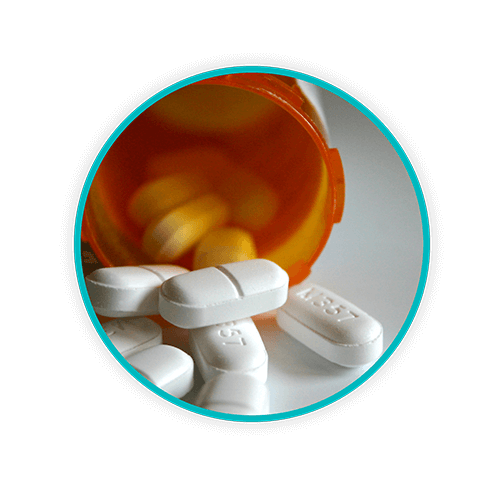What Is Pharmaceutical Waste?

Any facility that generates pharmaceutical waste needs to know and follow Canadian regulations regarding its handling and disposal. Knowledge of different pharmaceutical waste classifications and their disposal processes ensures compliance and reduces the risk of exposure to human health or the environment, as well as any accompanying fines or penalties.
TOPICS WE WILL COVER:
1 / Defining pharmaceutical waste
2 / Who makes pharmaceutical waste regulations?
3 / Types of pharmaceutical waste
4 / Staying compliant – Tips for safety
5 / Daniels Health Canada knows Pharmaceutical Waste Disposal Practices
Defining Pharmaceutical Waste
Pharmaceutical waste is defined as an expired or unused/leftover medication that can be classified as non-hazardous or hazardous, depending on its chemical properties. Such a determination also depends on its potential to risk human health or the environment.
Pharmaceutical waste not only applies to prescription drugs, but can also include over-the-counter medications and waste products left over from their manufacturing processes. Pharmaceutical waste can also include sharps, personal protective equipment (PPE), or anything that comes into contact with pharmaceuticals.
Pharmaceutical waste not only comes from healthcare facilities, but can also originate from households. Knowing the proper rules and regulations regarding its handling, storage, and disposal is essential. Several governmental agencies provide guidance when it comes to such regulations.
Who makes pharmaceutical waste regulations?
In Canada, the governmental agencies of each of the provinces provide information regarding pharmaceutical waste disposal. A number of documents and websites also provide a wealth of information to ensure compliance. For example:
- The Canadian Biosafety Handbook – This source offers detailed information regarding biotechnology and toxins such as cytotoxic drugs used in chemotherapy or radiation therapies. Be aware that toxins don’t replicate and are not transmitted from person to person but can cause exposure typically through accidental needle sticks or through the use of aerosols.
- Another government website, “Canada’s system for addressing chemicals,” is an excellent resource for standards and processes that protect not only human health, but the environment as well. The site categorizes federal laws that cover the environment and environmental health issues, including the Food and Drugs Act, the Canadian Environmental Protection Act, and the Transportation of Dangerous Goods Act.
- The Canadian government also provides information on the safe disposal of prescription drugs here, and covers topics such as takeback programs, options for those using pharmaceuticals in a home environment, and how to dispose of pharmaceuticals properly and safely. Despite takeback programs that collect prescription drugs, natural health products, and over-the-counter medications, only a fraction are expired or unused pharmaceuticals. In many cases, such items continue to be flushed down toilets or sinks or thrown away in trash by home users, ending up in soil and water sources.
- Public Safety Canada, another governmental agency, provides a broad document that covers Prescription Drug Return Initiatives in Canada.
- Canada Occupational Health and Safety Regulations (see Part X – Hazardous Substances) provided by the Justice Laws Website.
Following federal regulations is important, but so too is knowing and following the rules of your province or territory. For example, in Ontario, it is the responsibility of the producer to properly collect pharmaceuticals and sharps (Ontario regulation 298/12, under the Environmental Protection Act). Every province and territory can specify and mandate even more stringent rules for pharmaceutical waste disposal than that of the federal government.
Proper determination of pharmaceutical waste will determine its handling and disposal options.
Types of pharmaceutical waste
Pharmaceutical waste can be defined as non-hazardous, hazardous, or a controlled substance. The Canada Occupational Health and Safety regulations are an important document to review in regard to regulations and exemptions. For example, Part 10 of this act covers hazardous substances as well as information regarding storage, handling, use, and control of hazardous substances. Various criteria for identification are employed and include:
- Properties of a potentially hazardous substance (chemical, biological, and physical)
- Route of exposure to a hazardous substance
- Acute as well as chronic effects of exposure to that hazardous substance
- Manners in which a hazardous substance is used, stored, handled, and disposed of
It is noted in Section 10.8 that “Every hazardous substance stored, handled or used in the workplace shall be stored, handled or used in a manner whereby the hazard related to that substance is reduced to a minimum.”
In addition, Section 10.10 states that “Every container for a hazardous substance that is used in the workplace shall be so designed and constructed that it protects the employees from any health or safety hazard that is caused by the hazardous substance.”
Section 10.13 states that “Where a hazardous substances is stored, handled or used in the workplace, warnings shall be given in appropriate places at access points warning every person granted access to the workplace of the presence of the hazardous substance and of any precautions to be taken to prevent or reduce any hazard of injury to health.”
Staying compliant – Tips for safety
- Know the difference between trace and bulk chemotherapy drugs and follow guidelines for disposal.

- Correctly and appropriately label hazardous waste and ensure labels are visible and of the correct size.
- Maintain accurate and up-to-date records. Engage weekly inspections to make sure containers are up to standards. Ensure that all waste streams are properly separated, labeled, contained, and stored.
- Properly store pharmaceutical waste. Separate wastes based on whether you’re a small quantity generator, a large quantity generator, or a conditionally exempt small quantity generator. Know the difference between them.
- Create an emergency contingency plan. Every healthcare facility should have a written emergency response plan and adequate documentation of how such emergencies are dealt with.
- Be aware of the length of time you can store pharmaceutical waste, including cytotoxic pharmaceutical waste.
- Create a manifest or documentation for your hazardous materials, documenting when such materials have been shipped, transported, or destroyed.
Pharmacists are also held accountable for “cradle-to-grave” management of facility pharmaceuticals and are increasingly liable for improper disposal of regulated hazardous wastes. If you or your facility is involved in any way with pharmaceuticals, you are ultimately responsible for proper pharmaceutical waste disposal.
Adopting a cradle-to-grave approach is essential for any medical waste generator, implying that it is the generator’s responsibility to guide a pharmaceutical product from its generation to its disposal. Even hiring a medical waste disposal company does not remove the responsibility from the generator.
Daniels Health Canada knows Pharmaceutical Waste Disposal Practices
Don’t guess when it comes to pharmaceutical waste disposal practices. Know the rules not only of your province or territory, but the federal government as well. Compliance not only protects healthcare workers, but the public, wildlife, and the environment. For additional information regarding our range of services, containers (single-use or disposable), and to take advantage of our knowledge of regulations, call a Daniels Health Canada representative today.
Let's Talk!
Your time is valuable, and we don’t want to play hard to get. You can either phone us directly on the details listed on our contact page, or feel free to fill out this short form and one of our team members will get back to you as quickly as possible.
